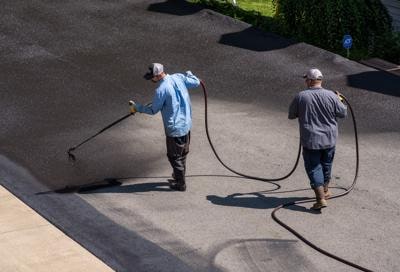Rejuvenate Your Property with Regrading and Asphalt Sealing Methods
Rejuvenate Your Property with Regrading and Asphalt Sealing Methods
Blog Article
Warm Mix Asphalt: A Lasting Option for Sidewalk
Hot Mix Asphalt (HMA) has actually become a leading lasting option for pavement solutions, offering a myriad of environmental benefits and ingenious innovations. Its capacity to reduce and recycle products power usage offers an engaging situation for its adoption in roadway construction projects. Furthermore, the long-term efficiency and resilience of HMA make it a favored choice for infrastructure growth. As the need for environmentally friendly construction techniques expands, exploring the nuances of HMA's sustainability can provide beneficial understandings into the future of sidewalk options.
Environmental Advantages of Hot Mix Asphalt

Furthermore, Warm Mix Asphalt helps to alleviate city heat island results. Its dark color soaks up sunlight, minimizing the amount of warm reflected back into the atmosphere compared to lighter-colored pavements. This can reduce ambient temperature levels in metropolitan locations, decreasing the demand for a/c and ultimately decreasing energy usage.
Additionally, Warm Mix Asphalt adds to enhanced stormwater monitoring. Its permeable nature permits water to reenergize and penetrate the sidewalk groundwater supplies, reducing runoff and the risk of flooding. These ecological benefits make Warm Mix Asphalt a lasting choice for paving roads and highways.
Power Performance in HMA Production
Is energy efficiency a critical variable in the manufacturing of Hot Mix Asphalt (HMA)? Power plays a substantial role in the manufacturing of HMA, affecting both expense and environmental sustainability. One essential aspect of power effectiveness in HMA manufacturing is the use of warm mix asphalt (WMA) technologies.
In addition, advancements in plant modern technologies have led to more energy-efficient HMA production processes. By maximizing energy usage in HMA manufacturing, the sector can minimize its carbon footprint while preserving high-grade pavement materials.
Recyclability of Hot Mix Asphalt
The recyclability of Hot Mix Asphalt (HMA) is a critical facet of its sustainability and long-term environmental effect. HMA is just one of one of the most recycled materials in the USA, with over 100 million lots of redeemed asphalt pavement (RAP) being recycled each year in new pavement building. Reusing HMA provides numerous environmental benefits, such as decreasing the requirement for virgin products, lowering power intake throughout manufacturing, and lowering the quantity of waste sent out to garbage dumps.
The procedure of recycling HMA involves milling the existing sidewalk, squashing it into smaller items, and blending it with new aggregate and asphalt binder to produce a recycled mix. On the whole, the recyclability of HMA plays a considerable function in advertising lasting methods within the pavement industry.

Long-Term Efficiency of HMA
Asphalt pavements show resilience and strength over a prolonged duration, showing useful site the lasting performance of Warm Mix Asphalt (HMA) Additionally, developments in HMA technology, such as the use of polymer-modified binders and cozy mix asphalt, have even more enhanced the toughness and durability of HMA sidewalks. By focusing on high quality building and construction and upkeep methods, HMA proceeds to prove itself as a affordable and sustainable remedy for long-lasting pavement framework.

HMA: Sturdiness and Sustainability
Demonstrating both resilience and sustainability, Hot Mix Asphalt (HMA) has actually ended up being a keystone in the building of long-lasting pavement facilities - angled parking. HMA's durability comes from its ability to hold up against heavy tons, harsh weather, and high website traffic volumes, making it a trusted option for highways, freeways, and flight terminal paths. The composition of HMA, which commonly includes aggregates, binder, and filler, plays a crucial role in boosting its longevity and resistance to tear her response and put on
Moreover, HMA's sustainability lies in its recyclability and energy-efficient manufacturing process. The capacity to reuse recovered asphalt pavement (RAP) in new HMA blends lowers the demand for virgin products and minimizes the environmental influence of pavement construction and maintenance. Furthermore, the power performance of producing HMA hinges on its lower mixing temperatures compared to other pavement products, resulting in lowered energy consumption and greenhouse gas emissions.
Final Thought
In final thought, hot mix asphalt (HMA) offers a sustainable remedy for sidewalk with its ecologically friendly features. HMA's recyclability, power effectiveness in manufacturing, and lasting longevity make it an eco-friendly selection for roadway construction.
HMA is one of the most recycled products in the United States, with over 100 million heaps of reclaimed asphalt sidewalk (RAP) being reused annually in brand-new pavement building and construction.The process of reusing HMA includes crushing the existing pavement, squashing it right into smaller items, and mixing it with brand-new aggregate and asphalt binder to develop a recycled mix.Asphalt pavements show sturdiness and resilience over a prolonged browse around here duration, showing the lasting performance of Warm Mix Asphalt (HMA) Furthermore, improvements in HMA modern technology, such as the usage of polymer-modified binders and warm mix asphalt, have better boosted the longevity and long life of HMA pavements. The capability to recycle reclaimed asphalt sidewalk (RAP) in brand-new HMA mixtures minimizes the need for virgin materials and lessens the environmental effect of sidewalk construction and upkeep.
Report this page